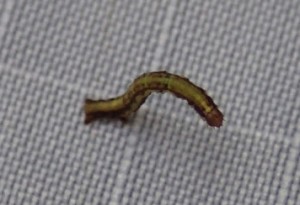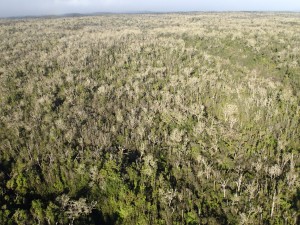Native Moth Outbreak Causing Defoliation of Koa Forests
State wildlife officials say large swaths of koa forest on the Big Island are losing their leaves, and a sudden outbreak of a native moth is to blame.
The culprit is the caterpillar of the koa moth, which is commonly found in koa forests, and which has been known to be responsible for prior defoliation episodes. Such events have been documented as far back as 1892, with similar oral accounts going back even further, said officials with the state Department of Land and Natural Resources.
However, this time the affected areas total nearly 25,000 acres, the largest koa defoliation on record. And based on previous episodes, the moth outbreak could spread further.
But since this is a natural phenomenon, the only action wildlife officials plan to take is to monitor and document the outbreak, with an eye toward figuring out how to predict its spread.
Many if not most of the trees are expected to survive.
Outbreaks on Maui in 2004 and 2009 showed that while up to 35% of the trees in forests under stress died as a result of the defoliation, in healthy forests the mortality rate is nearly zero.
Currently the affected trees are found between the 2,000-foot and 4,000-foot elevations near Hilo and in Hamakua.
“We are prioritizing monitoring efforts because it is important to understand how this outbreak might affect our forests and koa forestry on Hawaii Island,” said Roger Imoto, chief of the Hawaii Island branch of the DLNR’s Division of Forestry and Wildlife. “Despite the rapid and severe visual impact of defoliation caused by the caterpillars, it should be noted that koa can and do recover after such outbreaks.”
Both koa and the koa moth are endemic to Hawaii, which means they are found nowhere else.

It’s a little larva with a big appetite: The koa looper is eating its way through forests in Hilo and Hamakua. Photo by William Haines, CTAHR.
Like other caterpillars, the looper of the koa moth has a voracious appetite. It feeds only on koa leaves.
The moth’s life cycle lasts about two months, with the caterpillar stage representing about half of that.
It is not known what eventually causes moth populations to crash, which reduces the defoliation. Scientists say the outbreaks could be slowed by predators such as birds, spiders or other insect or by diseases. It could also be that they simply lose momentum as the food supply diminishes.
Meanwhile, the public is encouraged to report koa defoliation or increases in koa moths or their caterpillars in areas outside of Hilo or Hamakua.
“Mapping the boundaries of this infestation will tell us what areas are affected right now, and provide a way for us to measure movement of the moths into new forest areas,” Imoto said.

The deforestation is evident in this photo by William Haines, a faculty member at the University of Hawaii at Manoa. (Click on image to enlarge.)
The public can report new outbreaks by calling 808-587-0166 with information on the nearest street address, date of sighting, and a description of the defoliation. The public is encouraged to send photos with location information to [email protected].
Information on the koa looper is available at www.hawaii.gov/dlnr/dofaw.
The DLNR is being assisted in research of the outbreak by scientists from University of Hawaii, US Forest Service, US Geological Survey, and Hawaii Agricultural Research Center.















